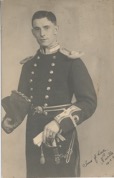Neville Lyon Humphreys

| Rank: | Sub-Lieutenant |
| Regiment: | Royal Navy, HMS Worcester |
| Country: | United Kingdom |
| Service Number: | unknown |
| Cemetary/Memorial: | Dover (St James’) Cemetary (Sec. U.C., Grave 10) |
| Awards: | 1939-1945 Star 1939-1945 War Medal Mentioned in Dispatches |
Born on 21st November 1914, Sub-Lieutenant Humphreys died 2nd June 1940, aged 25 of injuries sustained during the evacuation of the British Expeditionary Force from Dunkirk. He was Mentioned in Despatches for his bravery during the operation.
Son of William Edward Humphreys (1880-1955), a brewery manager and Florence Humphreys (nee Lyon, b 1888) of Liverpool.
Brother to William Edward (born 1912, married 1937) and Audrey (1917-2001).
Neville was a pupil at St Ronan’s from 1919 to 1922 before heading to Pembroke. In January 1924 he went to Birkenhead School, leaving at Easter 1925.
He was commissioned in the Royal Navy as a Sub-Lieutenant in June 1938. In April 1940, Humphreys was posted to the Destroyer HMS Worcester.
In his book, “Dunkirk Revisited”, John Richards details HMS Worcester’s part in the evacuation of the British Expeditionary Force from Dunkirk:
“A short while before sunset, HMS Worcester crawled unsteadily towards Dover harbour. Earlier, when she had navigated the Dunkirk Road and turned into the open sea. Succeeding attacks took place in the channel leading northward. In these attacks, the majority of bombs burst on impact with the water and caused great damage to personnel. Some of these dropped as near as 10 yards. In all it was estimated that over 100 bombs were dropped near the ship.
The attack resulted in forty-six dead and 180 injured. Six of the dead and forty of the injured were crew. Although the Captain had instructed them when bombs were released to lie down until they had exploded, Sub-Lieutenant Humphreys, remained standing to fire his Bren gun. He was shot in the chest.
There were 'splinter holes' all over the ship and those in the fuel tanks let water into them and succeeded in stopping Worcester five miles short of the North Goodwin Light Ship. The electrical circuits were damaged, as was also the anti-mine 'Degaussing' gear and the gyrocompass. The manoeuvring capabilities of both the propellers and the rudder were largely lost. The Captain reported wryly that 'only three holes were found below the waterline'[!]. Virtually all of Worcester's guns maintained their fire throughout, both in defence and in attack. It was reported that her anti-aircraft guns shot down two German planes.
The steam tug St. Olaves took Worcester in tow, but in less than an hour, the destroyer's engines were made to function again. So in due course, she limped unaided into Dover. Just as she approached the entrance, Southern Railway's Maid of Orleans came out. The Worcester was quite unable to take the necessary avoiding action. They collided. The Worcester sliced into the Maid's port side with a 'tremendous crash', and holed her. Many were thrown into the water – but there were plenty of tugs around to pick them up.
From HMS Worcester, Sub-Lieutenant Humphreys was rushed to Dover Hospital, but died of his chest wounds next day.”
HMS Worcester's record during Operation Dynamo was a good one. She made six trips to Dunkirk – two of them under very heavy attack. Altogether, she rescued 4,350 troops. Her action was deemed to be 'in the very highest traditions of her Service’.
On l6th August 1940, Sub-Lieutenant Neville Humphreys was awarded a posthumous Mention in Despatches for bravery during the Dunkirk evacuation.
